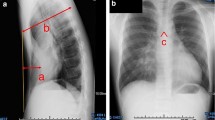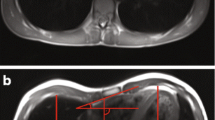Abstract
Background
Pectus excavatum is a common chest wall anomaly in children. Pre-operative imaging for pectus excavatum is performed with CT, which is used to calculate the Haller index to determine the severity of pectus excavatum.
Objective
To determine the correlation between Haller index values calculated with two-view chest radiographs and those calculated with CT and to determine, with CT as the reference standard, the diagnostic performance of radiographic Haller index for identifying cases that meet imaging criteria for surgical correction of pectus excavatum.
Materials and methods
For the period 2001–2009, our radiology information system was searched to identify all children who had undergone CT for Haller index calculation. Children who had also undergone two-view chest radiography (CXR) within 6 months of the CT were included in this retrospective study. Two radiologists independently calculated CT Haller index and radiographic Haller index. Data distributions were tested for normality with the Shapiro-Wilk W test. The associations between CT Haller index and radiographic Haller index were determined with the Spearman coefficient of rank correlation. Differences between CT Haller index and radiographic Haller index were tested with the Wilcoxon signed rank test. Haller index values were dichotomized into positive (>3.2) and negative (≤3.2) cases. Using CT as the reference standard, the sensitivity, specificity, and accuracy of radiographic Haller index in identifying children who meet imaging criteria for surgery were calculated.
Results
CT and CXR for evaluation of pectus excavatum were available for 32 children (25 male; median age 14.5 years). With CT, the median Haller indices for observers 1 and 2 were 3.4 and 3.5 and with CXR 3.5 and 3.5. There were statistically significant correlations between the radiographic Haller index and CT Haller index estimated by the two observers [Spearman correlation coefficient (95% confidence interval) for observer 1 = 0.71 (0.48–0.85, P < 0.01) and for observer 2 = 0.77 (0.52–0.88, P < 0.01)]. A statistically significant correlation was found between the radiographic Haller index calculated by the two observers [Spearman correlation coefficient = 0.98 (0.95–0.99, P < 0.01)]. Using CT Haller index as the reference standard, radiographic Haller index had a sensitivity of 0.95 (0.75–0.99), specificity of 0.75 (0.43–0.94), and accuracy of 0.88 (0.72–0.95) for observer 1, and a sensitivity of 0.95 (0.75–0.99), specificity of 0.67 (0.35–0.90), and accuracy of 0.84 (0.68–0.93) for observer 2.
Conclusion
Radiographic Haller index correlates strongly with CT Haller index, has good interobserver correlation, and has a high diagnostic accuracy for pre-operative evaluation of pectus excavatum. We suggest that a CT of the chest is not required for pre-operative evaluation of pectus excavatum, and a two-view chest radiograph is sufficient for preoperative imaging of pectus excavatum.


Similar content being viewed by others
References
Shamberger RC, Welch KJ (1988) Surgical repair of pectus excavatum. J Pediatr Surg 23:615–622
Nuss D (2008) Minimally invasive surgical repair of pectus excavatum. Semin Pediatr Surg 17:209–217
Haller JA Jr, Kramer SS, Lietman SA (1987) Use of CT scans in selection of patients for pectus excavatum surgery: a preliminary report. J Pediatr Surg 22:904–906
(2009) Clinical policy bulletin: pectus excavatum and Poland’s syndrome: surgical correction. Number 0272. Available via http://www.aetna.com/cpb/medical/data/200_299/0272.html. Accessed 23 Nov 2009
Shrimpton PC, Jones DG (1993) Normalised organ doses for x-ray computed tomography calculated using Monte Carlo techniques and a mathematical anthropomorphic phantom. Radiat Prot Dosim 49:241–243
Khursheed A, Hillier MC, Shrimpton PC et al (2002) Influence of patient age on normalized effective doses calculated for CT examinations. Br J Radiol 75:819–830
Hart D, Jones DG, Wall BF (1996) Normalized organ doses for paediatric x-ray examinations calculated using Monte Carlo techniques. NRBP-SR279. National Radiological Protection Board, Chilton
ICRP (1990) 1990 recommendations of the international commission on radiological protection. Annals of the ICRP, publication 60. Elsevier, Philadelphia
ICRP (2008) ICRP publication 103. Recommendations of the ICRP. Annals of the ICRP. Elsevier, Philadelphia
Nuss D, Croitoru DP, Kelly RE Jr et al (2002) Review and discussion of the complications of minimally invasive pectus excavatum repair. Eur J Pediatr Surg 12:230–234
Aronson DC, Bosgraaf RP, Merz EM et al (2007) Lung function after the minimally invasive pectus excavatum repair (Nuss procedure). World J Surg 31:1518–1522
Welch KJ (1958) Satisfactory surgical correction of pectus excavatum deformity in childhood: a limited opportunity. J Thorac Surg 36:697–713
Derveaux L, Clarysse I, Ivanoff I et al (1989) Preoperative and postoperative abnormalities in chest x-ray indices and in lung function in pectus deformities. Chest 95:850–856
Rebeis EB, Campos JR, Fernandez A et al (2007) Anthropometric index for pectus excavatum. Clinics (Sao Paulo) 62:599–606
Chang PY, Chang CH, Lai JY et al (2009) A method for the non-invasive assessment of chest wall growth in pectus excavatum patients. Eur J Pediatr Surg Nov 6 [Epub ahead of print]
Daunt SW, Cohen JH, Miller SF (2004) Age-related normal ranges for the Haller index in children. Pediatr Radiol 34:326–330
Mueller C, Saint-Vil D, Bouchard S (2008) Chest x-ray as a primary modality for preoperative imaging of pectus excavatum. J Pediatr Surg 43:71–73
Rattan AS, Laor T, Ryckman FC et al (2010) Pectus excavatum imaging: enough but not too much. Pediatr Radiol 40:168–172
Kuenzler KA, Stolar CJ (2009) Surgical correction of pectus excavatum. Paediatr Respir Rev 10:7–11
Haller JA Jr (2000) Complications of surgery for pectus excavatum. Chest Surg Clin N Am 10:415–426, ix
Mettler FA Jr, Bhargavan M, Faulkner K et al (2009) Radiologic and nuclear medicine studies in the United States and worldwide: frequency, radiation dose, and comparison with other radiation sources—1950–2007. Radiology 253:520–531
Author information
Authors and Affiliations
Corresponding author
Rights and permissions
About this article
Cite this article
Khanna, G., Jaju, A., Don, S. et al. Comparison of Haller index values calculated with chest radiographs versus CT for pectus excavatum evaluation. Pediatr Radiol 40, 1763–1767 (2010). https://doi.org/10.1007/s00247-010-1681-z
Received:
Revised:
Accepted:
Published:
Issue Date:
DOI: https://doi.org/10.1007/s00247-010-1681-z




